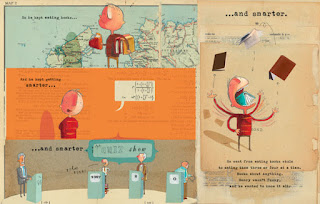Bright Agency
Bright is an agency for children's book illustrators, they have a really wide variety of styles and illustrators that go across the range from young childrens picture books to educational, typography, black and white and many others.
Taken from Bright's website
"We have always been recognised for our role in developing illustrators and have discovered and launched the careers of some of the best unpublished artists to hit the scene in recent years.
As agents, we see it as our responsibility to give help, encouragement and direction to our artists and the Bright Group exists to do just that. We influence and encourage our artists on the direction of their careers – helping them to tailor their work to the needs of the market, without losing touch with their creative personality.
Above all, we listen to our artists – some desperately want to be trade picture artists, others are financially driven or solely work on decorative/stationary books, whereas some just want to draw dragons! Whatever direction our artists want to take we work tirelessly to help them achieve their aims and find the right work from the right clients. If this means working directly with them to create the perfect portfolio pieces to win a particular commission, then our in-house art director is on hand to help.
The Bright Group is also available to help established artists looking for a change in direction – many artists who have already enjoyed a successful career may look to follow a different creative path and when that happens, we are right behind them. We have resurrected big name artists and re-launched them with new styles and pseudo-names. We have been able to triple the income of established professionals by seizing opportunities that may exist outside that artist’s main creative channel. For example, we have helped a stationery artist move into decorative gift books, and moved a top picture-book artist into children’s packaging and clothing ranges.
Whether you are just starting out, or are at the peak of your career, the Bright Group is here to help and guide you. We work with and for our artists and that’s why we have been able to deliver the most creative results in artist representation that the children’s market has seen in recent years."
There submission process is quite simple and easy all you have to do is send a collection of 10-12 images of your work to be considered for representation.
Artist Submissions
We are a busy agency and therefore receive hundreds of submissions each week. We love receiving artwork and will be happy to look at your samples but it is crucial that you follow our guidelines below.
If you are a talented artist looking for representation please send us 10 – 12 low res jpeg samples attached to submissions@thebrightagency.com We do not accept any other file formats or zipped file attachments. We regret that we cannot look at external websites.
This agency is based in London and submitting my own portfolio is something i will be interested in doing in the future.
Beehive Illustration Agency
Beehive is a uk agency representing children's illustrators. They have a great opportunity for illustration graduates to showcase their work on their website.
I think this is a great way to get your work out there and be seen by potential clients.
Walker Books
Walker is a publisher of children's book that range from young children's picture books to teenage fiction, they represent both authors and illustrators. Walker accept submissions of illustrated picture book to be considered for publication, the submission process is on their website.
How do I submit a manuscript/illustrate books for you?
While we do not accept fiction manuscript submissions, we are happy to accept illustrated picture-book stories and/or artwork samples via post or email.
While we do not accept fiction manuscript submissions, we are happy to accept illustrated picture-book stories and/or artwork samples via post or email.
POSTED SUBMISSIONS
ILLUSTRATED PICTURE-BOOK STORIES: Please send an illustrated dummy and/or a typed manuscript.
ILLUSTRATION SAMPLES: Please send eight to ten colour samples or a CD showing your work.
These should be accompanied by a stamped, self-addressed envelope for us to return your material to you if we decide not to pursue it. Material received without the appropriate SAE will be recycled. Please note, we can no longer return any material sent from outside the UK, even with international response postage coupons.
Please do not send original artwork or dummies, only copies, as Walker Books cannot accept liability for loss of or damage to material submitted.
We regret that we are unable to enter into any correspondence about submissions or discuss them on the telephone. As we receive a large number of submissions in the post each week, please allow up to three months for us to respond. We appreciate your understanding in this matter.
Please send your dummy/samples to:
Illustrator Submissions
The Art Department
Walker Books Ltd
87 Vauxhall Walk
London
SE11 5HJ
Illustrator Submissions
The Art Department
Walker Books Ltd
87 Vauxhall Walk
London
SE11 5HJ
EMAIL SUBMISSIONS
Illustrated picture-book stories or illustration samples should be sent as a jpeg or PDF for images (5 MB size limit) and as a Word document for text. Unfortunately we are unable to reply to email submissions unless we are interested in your work.
Please send email submissions to: illustratorsubmissions@walker.co.uk
For further information and advice, we suggest you check the following websites: http://www.writersadvice.co.uk;http://www.writersandartists.co.uk/
Walker also offer work expierience placements in their company, which i think is a great opportunity to see how a big publishing company works, available placements are advertised on the website and you apply by email to be considered.





































